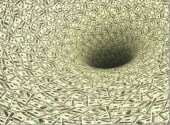 The Death of Money
The Death of Money
The Coming Collapse of the International Monetary System
By James Rickards
368 pages
Portfolio Penguin
Money is a very useful thing. So useful, in fact, that the notion that it can “die” strikes some of us as inherently implausible. Its demise would leave us, after all, with barter and that system’s much-discussed difficulties. The phrase “The Death of Money” is close kin to “The Death of Breathing” or even “The Death of Mortality”! Some things are just baked in to the human condition.
So when I heard that James Rickards’ new book bore that title my reactions were mixed. Had it come attached to most other possible author’s names I would have dismissed it as crackpottery. Yet it came from James Rickards, author of Currency Wars (2011). Rickards is a level-headed observer of the international monetary scene.
So what is his new book about? To begin: the subtitle is a better representation of the contents than the title. The book is about the end of a particular phase in the long history of money, the reserve significance of the U.S. dollar. It is also about the likely consequences of that phase’s endgame on the world financial system as a whole.
Three Claims
I will focus here on three particular claims of his, Rickards’, likely to interest the readership of AllAboutAlpha especially:
- The common refrain, “yes, the U.S. has quantitative easing, but we don’t yet have a significant degree of price inflation” is delusional, an artefact of our inadequate systems of measurement;
- There is no other currency in a position to step into the place of the U.S. dollar as the currency of the world’s currencies; and
- The world’s central bankers anticipate that there will be a turn to gold. Indeed, some of their policies (such as their manipulation of the price of that metal) are best understood as an effort to allow for the rebalancing of gold holdings among the major economic powers, a rebalancing that the bankers want to conclude “before the collapse of the international monetary system.”
On the first point, Rickards acknowledges early on that “widely followed U.S. dollar inflation measures such as the consumer price index have barely budged since 2008.” But this is most likely the fault of the measures, not the genuine piece of good news it might seem.
Inflation is an unquestioned fact in China at the moment, as well as in Brazil, where price increases in basic services such as bus rides have triggered civil violence. In the early days of the Arab Spring, food prices were among the catalysts. So: why would the U.S. be exempt?
It isn’t. Alternative baskets of goods and services (alternatives, that is, to the complacency-reinforcing traditional measures) suggest an inflation rate as high as 9% a year, and showing up especially in milk, bread, and gasoline prices.
No Alternative
On the second point, Rickards observes that no other currency ‘’ “yuan, yen, won, real, or peso” is in a position to become a reserve currency. This isn’t to deny the fact that each of those can serve “perfectly well as trade currencies for transactions that would previously have been invoiced in dollars.” They can, in that way, contribute to or help measure the dollar’s decline. What they can’t do is … replace it.
To the third point then: what are the central bankers doing? It makes little sense to hope that the central bankers will yet steer us away from an oncoming iceberg, because they seem too busy lowering the lifeboats (and allocating the space thereon.)
Central banker manipulation of gold prices is nothing new. It has always been part of the every-currency-for-itself system of ‘free floats’ introduced by President Richard Nixon. As early as 1975, Rickards says, then-Fed chairman Arthur Burns sent President Gerald Ford a memo suggesting that inflation can be managed by manipulating gold process downward. [Well, it was a more realistic idea than those WIN buttons.]
In our own time the central bankers expect that they world will have to return to gold at some point, and with that in mind they hope they’ll be able to do this in an orderly fashion, with the major powers all on board. To that end, the central bankers are trying to rebalance the gold holdings so that all the major powers will be holding enough gold to sign on to its re-monetization when the time comes.
As to hedge funds, Rickards suggest that certain of the funds – and in particular certain of their strategies – ought to be part of the portfolio of a wise investor. These include strategies that “target natural resources, precious metals, water, or energy.”



